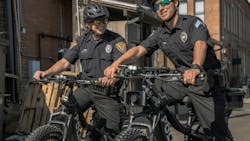Electric Bicycles on Patrol Continue to Evolve for Police Officers
Two-wheeled patrol vehicles for law enforcement aren’t anything new. Motorcycles and bicycles have been in use for a long time. Take a look at either, and you’ll see decades of evolution that have made both more suitable to the demands of patrol, to carrying the requisite equipment and to comfort. For decades, though, the only options for power were internal combustion engines or leg power. While electric-powered vehicles have been around for quite some time, the power sources themselves have always been too large and too heavy… until the last decade or so.
This article appeared in the March/April issue of OFFICER Magazine. Click Here to subscribe to OFFICER Magazine.
Once the power sources got small and light enough to be practical, along came the electric bicycle. They may be more popular in the commercial market—for recreational riding and local transportation—but they are growing quickly enough in the law enforcement community. The most important factor was the weight of the battery and what it added to the bike. An officer pedaling a bike that weighs a few pounds is one thing but add a battery that doubles the weight (or more) and you make it impractical as a patrol tool. When the batteries got light enough, the use of the bikes started to grow.
If you take a look at the available electric bikes being sold specifically for law enforcement use, you’ll find a few common design features and good utilitarian characteristics. The typical electric patrol bike is powered by a lithium-ion battery and an LCD control to manage the power. As with the mopeds of old, the motor can be used as much or as little as the officer desires, and they have several different levels of power assist to make pedaling as easy or hard as the officer can manage.
There are a couple of key strengths to any bicycle patrol program, not the least of which is the community relations strength of face-to-face officers moving not much faster than officers on foot patrol. For many decades now, officers have been separated from the communities they serve by patrol car doors and windows. By putting officers on bicycles, they become more approachable; more personable. They become perceived more as people and less just as “the police.”
Another strength is that bicycles are more maneuverable than patrol cars and can go places that other officers can’t unless they are on foot, on horseback or on a motorcycle. The ability to go those places is directly related to weight and the patrol officer’s endurance when it comes to peddling.
There are challenges to electric bicycles on patrol though. With motor power assist, officers can stay on patrol longer and go farther with less fatigue. That power balance allows for carrying more weight than could be carried before as well. A quick look around online, and discussions with a variety of officers who have worked bicycle patrol, reveals that most of the electric bikes in use can go 50-plus miles on a single charge and up to 28 mph.
Electric bikes come in a variety of sizes so agencies can fit different officers. Yes, seat height can always be changed but that’s not all there is to fit. The bikes can be purchased fully equipped, customized for equipment, and selected by size. Some manufacturers make at least four size bikes available, two different tire sizes and a selection of other options.
One of the biggest challenges faced by agencies wanting to add electric bikes to their list of patrol vehicles is perception and general knowledge. Simple lack of information can cause an agency to hesitate. Cost can be a speed bump too. Enacting an electric bicycle program isn’t the same as starting up a bicycle program “back in the day.” Thirty years ago, if an agency wanted to start a bicycle patrol program, they went out and bought a few mountain bikes, added some accessories like lights and saddlebags and put some stickers on the bikes. A couple officers, those who rode recreationally, got assigned and voila, a bicycle patrol program was born. Total cost? Less than $2,000, and that included the bike racks mounted on the back of the patrol car or SUV.
If you do a search online for “electric patrol bicycle,” you’ll find an assortment of options available with costs running from $2K-$5K. The final cost depends on the options you choose and the capabilities of the bikes. Add to that the necessity of training and putting two bikes into a new patrol program can cost upwards of $6k-$10K.
Don’t let the potential cost scare you away from the idea though. The benefits can be leveraged to increase patrol efficiency in targeted areas, community relations in challenged neighborhoods, and uniformed presence in areas seeing increased crime rates. The mobility and visibility of a bicycle patrol program can have a strong deterrent impact on crimes of all types.
When you’re planning a new or expanded bicycle patrol program, don’t forget to include the costs of uniforms, training (as mentioned), transport racks and other related expenses. When initiating such a program, plan it out months in advance. Yes, that’s obvious for budgeting purposes, but plan the patrol and assignment schedule as well. Know the timeline from ordering the equipment to taking delivery to the officers attending training to the patrol schedule for the first month or so after training is successfully completed.
Obviously, starting a program early in the spring is ideal but may not coincide with your budget schedule. Find a way to juggle that challenge so that you can have officers attending training with a graduation date prior to Memorial Day. That way you can leverage the full value of the new (or added) bicycle units for the entire summer—having the greatest potential to impress the powers that be.
This article appeared in the March/April issue of OFFICER Magazine.
About the Author
Lt. Frank Borelli (ret), Editorial Director
Editorial Director
Lt. Frank Borelli is the Editorial Director for the Officer Media Group. Frank brings 20+ years of writing and editing experience in addition to 40 years of law enforcement operations, administration and training experience to the team.
Frank has had numerous books published which are available on Amazon.com, BarnesAndNoble.com, and other major retail outlets.
If you have any comments or questions, you can contact him via email at [email protected].

